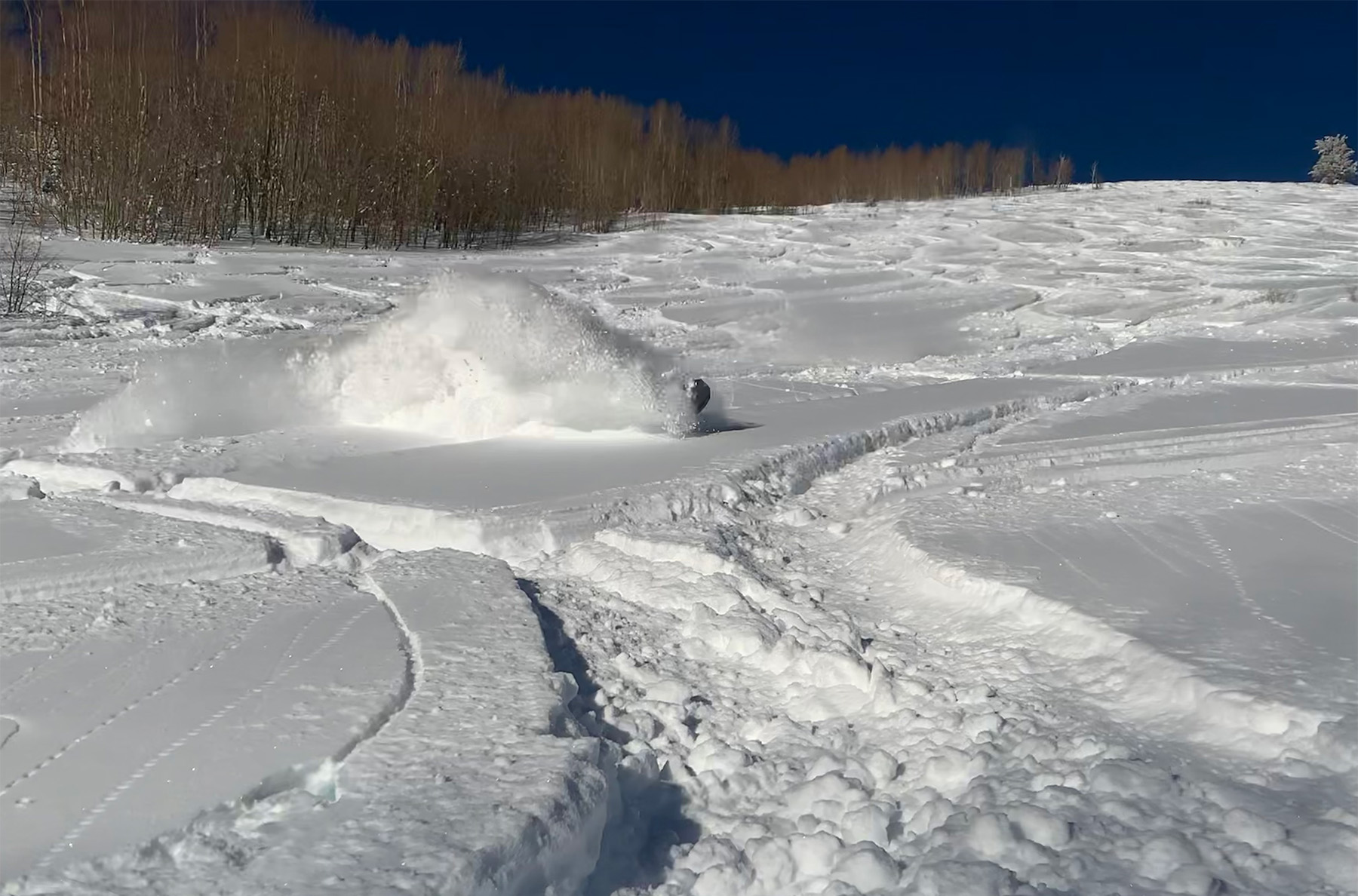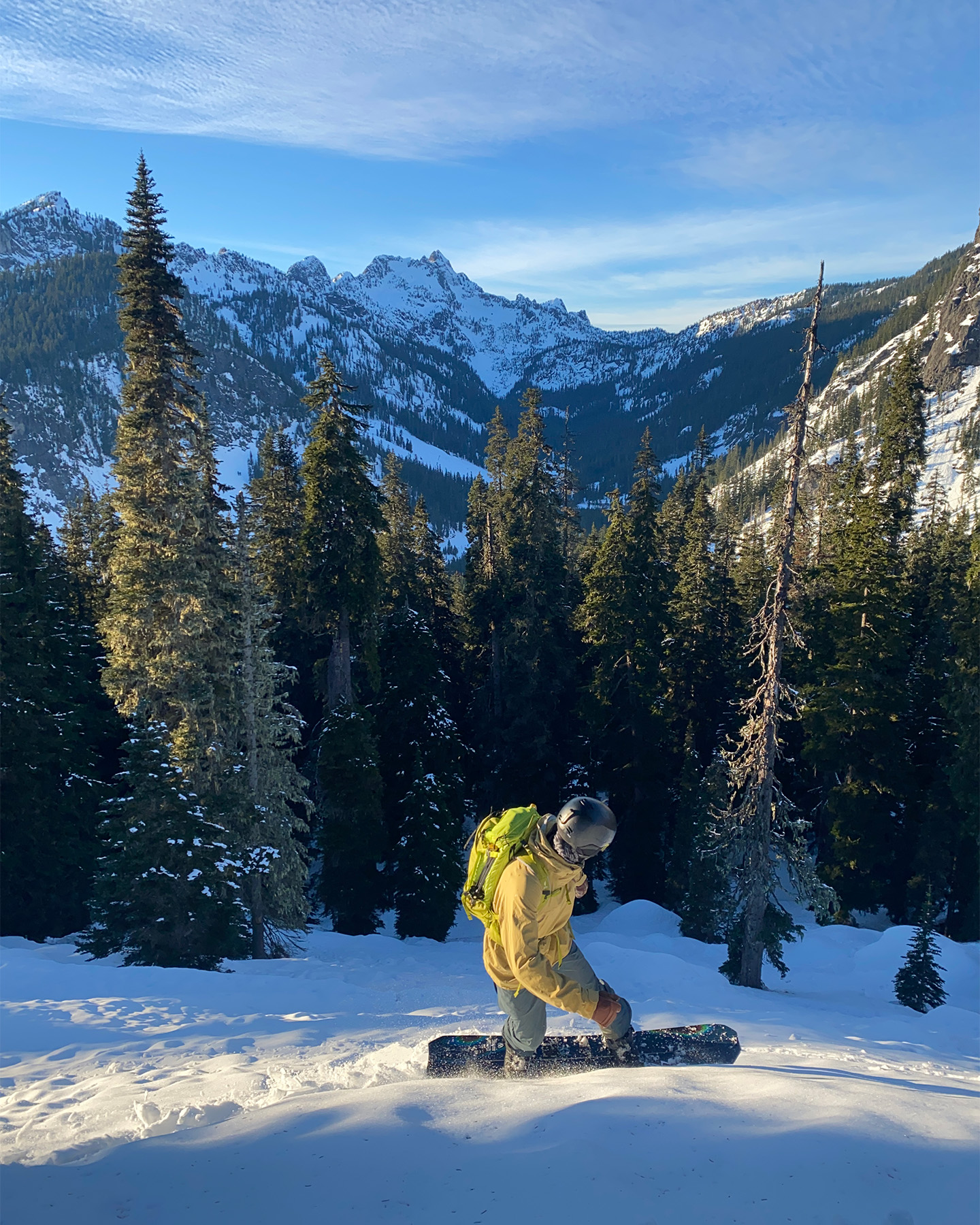Board: 2022-2023 Lib Tech Orca Split, 159 cm
Test Locations:
- Hatcher Pass, Turnagain Pass, & Girdwood, AK
- Mount St. Helens, Alpine Lakes Wilderness, Mt. Baker Backcountry, & Tatoosh Range, WA
- Wasatch Range, UT
Days Ridden: ~20
Available Sizes (Length-width): 150, 153, 156, 159 cm
Size Tested: 159 cm
Stated Nose / Waist / Tail Width (159 cm): 311-267-302 mm
Stated Sidecut Radius: 8 meters (7 meters @ 150 cm)
Setback: 3.8 cm / 1.5 in
Stance: 43.2-60.9 cm / 17-24 in
Boots Used: K2 Aspect, Ride Trident
Bindings Used: Spark R&D Arc Pro
Stance: 21”, 15°, -6°
Reviewer: 6’2”, 165 lbs

Intro
Lib Tech (and parent company Mervin Manufacturing) is truly an all-American snowboard company. Based in the Puget Sound and manufactured in Sequim, WA, Lib Tech has been the source of several important advances in snowboard technology, including the now ubiquitous reverse camber (introduced as Banana Tech in 2006) as well as Magne-traction, Lib’s serrated sidecut technology. Lib Tech and Travis Rice also became notable players in the volume-shifted board movement with the introduction of the (solid) Orca in 2019. Designed to be sized 3-5 cm shorter than a normal board, its tight sidecut, wide overall build, and well-balanced directional flex and camber profile proved to be incredibly popular. T. Rice and Lib Tech took their time designing the Orca Split, redesigning the tail for better uphill performance and more downhill dependability, given the structural changes in a split. Having ridden the Orca solid a few times, I was eager to try the split, and I’ve been able to do just that over the past two seasons.

Construction & Shape
Overall, the Orca split is a wide, volume-shifted board, but does have some subtle changes in geometry from the solid version. The split is slightly narrower than the solid (308 mm nose vs 317 mm in the solid, for the 156 cm size), is slightly less tapered (7 mm vs 11 mm), and with a longer sidecut (8 m vs 7 m). The tail has considerably less kick than the solid Orca, which does help with skin compatibility. The Orca Split is made from Lib’s top-tier materials and construction tech: 7-point Magne-traction, a sintered base, top-mount 3D clip inserts with Karakoram clips, thinned tip and tail construction, full wood core (95% paulownia / 5% aspen), triaxial and biaxial fiberglass (though it’s not clear what the distribution of said glass is), and a bean-derived top sheet material.
Rocker Profile & Flex Pattern
Lib Tech’s C2x camber pattern employed on the Orca Split is essentially a tight area of rocker between the bindings with two distinctly designed camber sections under each foot. The nose section of camber is quite mellow and paired with a similarly forgiving flex (6/10), without an additional early rise section in the nose. The tail’s flex is fairly stiff (8/10), but the between-the-feet rocker makes the stiff tail much easier to load than in camber-underfoot designs like the Rossignol Sashimi. The combination is very energetic, with a lively feel when coming out of turns that I’d typically expect from more camber-heavy boards. Lib Tech lists an overall flex rating of 8/10 for the Orca Split, which seems accurate to me.
FULL REVIEW
Uphill Performance
With the Orca’s C2x rocker profile, I did have some initial concerns about how it would perform on icy climbs, but overall I’ve been quite impressed. The shorter length (159 cm in my case) makes it feel very lightweight and maneuverable for kick turning, so much so that I haven’t noticed a practical difference in weight from the 161 cm Venture Storm Carbon. The Orca Split’s Magne-traction sidecut has been impressively grippy while side-hill skinning, and I haven’t noticed the rocker profile negatively affecting grip. Overall, the Orca Split has been, well, solid on the uphill. One notable caveat is that any buyer of the Orca Split should choose their skins intentionally, since the fish-style tail does not have a standard shape and might not fit some splitboard tail clips. I used Voile Hyper Glide skins and found that switching the right and left tail clips did the job.

Downhill Performance
Powder
Most snowboards are fun in powder, and the Orca Split is no exception. It floats well and the volume-shifted, tapered design with a healthy serving of reverse camber between the feet makes for a good time in soft snow. Obviously, the Orca Split does not float as well as other more niche, big-quiver-oriented boards with more taper and more traditional fish-style tails, but not so much that I was reaching for other splits on deep days. I tested the float in some very dense, deep maritime snow and didn’t find myself submarining any more than I would with the Venture Storm Carbon, another versatile favorite.

Hardpack
Despite the small changes in width and sidecut, relative to the solid version, the Orca Split is still dependable and responsive on hardpack. It’s quite maneuverable overall. In steep couloirs or jump-turn situations, the edge hold was dependable, and I didn’t feel the board’s width holding me back from making quick moves.
The wider build also helped to limit toe drag and was reassuring in steeper, high-exposure situations. I found that if I shifted my weight slightly forward, the Orca Split was amenable to slarvy, looser turns, while with my weight back, it was much more responsive and stable. Though this took some getting used to initially, it overall makes for a versatile split that works well in harder snow conditions. During a particularly depressing period with no fresh snow for weeks in the Cascades, along with some frozen rain at lower elevations, my tours inevitably included harrowing exits through dense trees on bulletproof ice, and the Orca Split was serviceably precise and responsive without being overly catchy.
Chop / Variable Snow
The Orca Split excels in variable snow conditions. It was designed to modify the standard fish-style chassis to improve high-speed capability and freeride performance, and in my experience, it does just that. During a spring trip to the famed Hatcher Pass in Alaska’s Talkeetna Range, variable wind, solar effects, and a variety of ridable aspects made for a diverse range of snow conditions in an average day. When I needed the Orca Split to be a nimble, poppy freestyle deck, it delivered, providing strong snap off the tail and a lightweight, maneuverable ride. When I needed more of a stable, high-speed ride, the stiff, longer tail was quite stable at high speeds, and the mellow-cambered nose was effective at plowing through chop without much of the twitchiness that I’d expect, given its overall maneuverability.

On a beautiful February morning, a high-speed descent of Mount St. Helens in corn conditions on the Orca Split made for one of the best runs in recent memory. Stable, long-radius turns with minimal chatter transitioned seamlessly to slashes and snappy ollies into gullies. No two touring days are the same, and I found that the Orca Split was agreeable to many different riding styles in many different snow conditions.

Durability
I did have some mild durability issues with the Orca Split after a season of use, namely a chipped top sheet on the tail that I failed to fix in a timely fashion and subsequently grew throughout the review period. Lib Tech uses a top sheet material that’s derived from castor beans and is less environmentally harmful than traditional, petroleum-based materials, and other than said tail chip, it held up well to split crampon nicks and other daily abuse. Lib Tech has long been in the tradition of foregoing full-wrap metal edges on the nose and tail, presumably to reduce swing weight (they also thin the nose and tail core profile for a similar purpose). I found that the wear and tear from uphill scrapes, nicks, and bashes was slightly more prominent than in past splits, given the lack of a full-wrap edge. The sintered base was solid when faced with average rock impacts, of which I had several. I wouldn’t say that the Orca Split’s durability was substantially lower than most splitboards, but its design and materials are prioritized in a way that emphasizes performance and reduced environmental impact over durability. Compared to many of the lighter, ultralight carbon splits, the Orca is still quite durable.
Comparisons
Rossignol Sashimi Split
The Sashimi Split, while also volume-shifted, rides decidedly more like a directional board than the Orca Split. The Orca is more versatile, rides less like a pintail, and has better landing gear — in my mind, all of this makes it a better daily driver. The Sashimi is significantly less expensive, still quite capable, and gets the nod as a powder-oriented quiver piece to pair with a more stable, more versatile split.
The Storm is significantly softer than the Orca, is much surfier and pliable overall, and is less comfortable at speed. The Storm is a better quiver-killing option for someone who wants a more maneuverable, softer ride, while those wanting to add some stability at speed should go for the Orca. The Storm is also a more durable split overall. While the Orca isn’t built with weight-saving carbon, it is still a lightweight splitboard in practice.
Jones Ultracraft Split
The Ultracraft is a responsive, snappy charger that lacks the variable-snow versatility of the Orca, but is significantly lighter. The Ultracraft also has a traditional camber-dominant underfoot profile. The Orca Split, while lightweight overall, will not satisfy the very weight-conscious in the same way that the Ultracraft will, but is much more capable of surfy, playful riding.
Bottom Line
The Lib Tech Orca Split is a versatile, volume-shifted splitboard with an innovative design that pairs well with a variety of snow conditions and riding styles. From wide-open AK lines and PNW volcano surfing to icy forest exits, I found it to be a suitable quiver killer that makes for dependably fun days in the backcountry.


Stoked to see the return of the snowboard/splitboard reviews! Keep ’em coming!
I’ll second that stoke! Great review and love the comps to other splitboards.
What does “volume-shifted” mean? Kept hoping for a definition in the review.
Volume shifted is a marketing term that a snowboard is made a little wider and shorter. Or if you have larger feet, a board is just wide enough, but still too short. It is borrowed from surfboard design where boards were made shorter with more thickness, usually in the front 1/3, (so average surfers can perform ugly air reverses in uninspiring waves*)
*opinion only, lol
Such a great review!
Hey- what skins did you use? I’m seeing a lot online about having issues with clips and want to make sure I get the right set up.